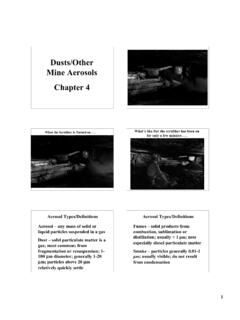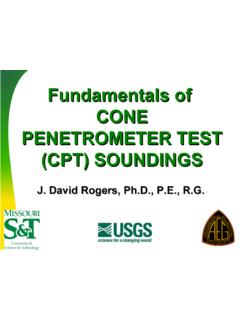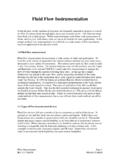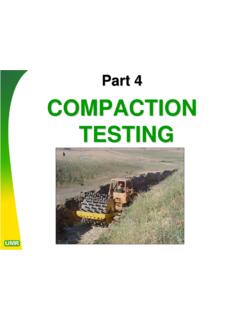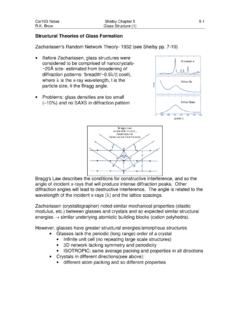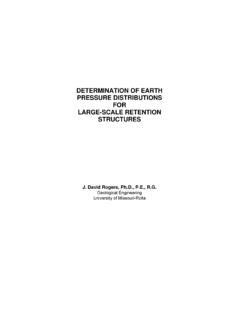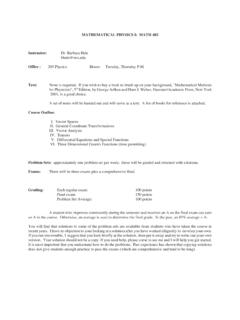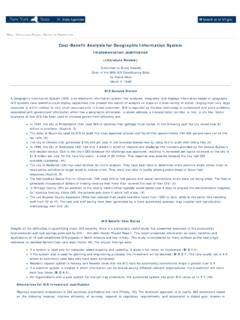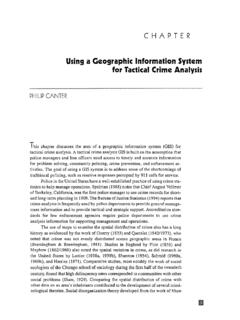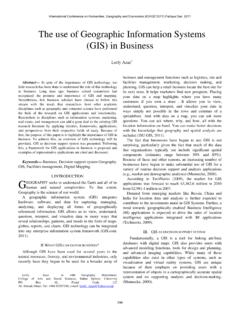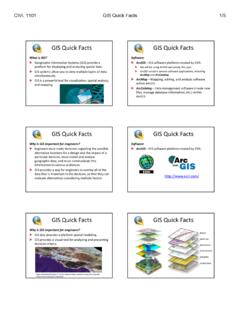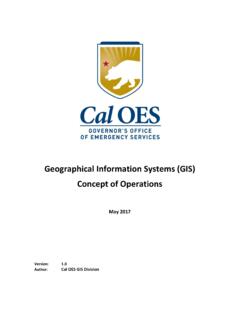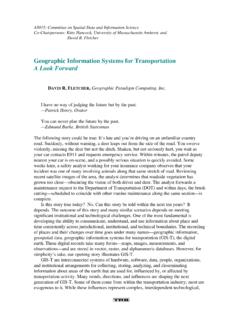Transcription of BRIEF HISTORY OF GEOGRAPHICAL …
1 BRIEF HISTORY OF BRIEF HISTORY OF GEOGRAPHICAL GEOGRAPHICAL information information SYSTEMSSYSTEMSIan Ian McHargMcHarg(1920(1920--1981)1981)thethe Father of GISF ather of .. Ian L. McHargwas born and raised in Scotland. He came to the United States after World War II to get a master s degree in 1952In 1954 he took a position as Professor of Landscape In 1954 he took a position as Professor of Landscape Architecture and Regional Planning at the University of Architecture and Regional Planning at the University of Pennsylvania and came to be recognized worldwide for Pennsylvania and came to be recognized worldwide for introducing ecological concerns into land planning from introducing ecological concerns into land planning from the midthe mid--1960s onward.
2 An ardent environmentalist and 1960s onward. An ardent environmentalist and writer, he was one of the prime movers in organizing the writer, he was one of the prime movers in organizing the first Earth Day in 1970. He was a partner in the landscape first Earth Day in 1970. He was a partner in the landscape architecture and environmental planning firm Wallace, architecture and environmental planning firm Wallace, McHargMcHarg, Roberts and Todd., Roberts and Todd. Ian Ian McHargMcHarg(1920(1920--2001) is credited with being the father 2001) is credited with being the father of map overlays, which had a major impact on of map overlays, which had a major impact on GEOGRAPHICAL information SystemsGeographical information Systems He was a Professor of Landscape Architecture and He was a Professor of Landscape Architecture and Regional Planning at the University of Pennsylvania from Regional Planning at the University of Pennsylvania from 19541954--20012001 He wrote He wrote Design with NatureDesign with Naturein 1969in 1969 McHargsaw industrial centers as urban plight.
3 Filled with pollution that ultimately damaged one s soul as well as health McHargfelt that mass grading by engineers created sterile man-made environments devoid of aesthetic buffers in their rush to mass produce the maximum number of units in a minimum space. He felt hat this was inevitably unhealthy for society at large Before (1971) and after (1977) development views of Deep Canyon in Los Angeles Ian Ian McHargMcHargdescribed engineers described engineers as those as those who, by who, by instinct and training, were especially instinct and training, were especially suited to gouge and scar landscape suited to gouge and scar landscape and city without remorse and city without remorse McHarg sstarting point was usually a physiographic section, like that shown here.
4 He argued that form must form must not follow function, but must also respect the natural not follow function, but must also respect the natural environment in which it is placedenvironment in which it is placed. Note the. Note theplacement of structures in the forested slopes which made them almost unnoticeable. McHargtook landscape principles of aesthetics and applied these to maps McHarg sBasic Amenity Mapportrayed slopes with wooded cover as a valuable asset, akin to a city park. Earth sheltered structures could be constructed on the slopes if they were embedded into the rock with a minimal loss of tree cover.
5 Hence the term urban camouflage , or designing with nature McCargusually began with a Physiographic Features Map. This example compared forest cover, aquifer recharge, 50-yr flood plain, streams, slopes >25% and impervious soils in a master overlay. In the early years these hybrid maps were constructed of acetate overlays on a cadastral base map. McCarg sMcCarg sOptimal Land Optimal Land Use MapUse Mapcombined combined physiographic physiographic features with features with existing existing infrastructure, infrastructure, development development and zoning and zoning restrictions restrictions which were which were weighted to weighted to the taste of the taste of local residents local residents and regulatory and regulatory boards.
6 Boards. McHargpioneered the use of map overlays to highlight intrinsic natural features, that commonly included flood zones, wetlands, woody vegetation stands, slopes, drainages, aquifer recharge zones, areas under cultivation and man-made features. Each asset could be assigned an arbitrary value, depending on societal input. Physiographic features were catalogued as separate maps. McHargwould then overlay these to create a composite map illustrating physiographic containing multiple features would appear as the darkest might be valued more than lighter colored areas. McHargMcHargalso also demonstrated that a demonstrated that a plethora of societal plethora of societal traits could be traits could be represented on maps represented on maps as well, and overlain as well, and overlain in much the same in much the same manner as composite manner as composite physiographic physiographic obstructions.
7 These obstructions. These tended to mimic tended to mimic property values. property values. McHarg sMcHarg smap overlay method gained national map overlay method gained national recognition in a consulting project for a 5recognition in a consulting project for a 5--mile stretch mile stretch of the controversial Richmond Parkway on Staten of the controversial Richmond Parkway on Staten Island in 1968 Island in 1968 McHarg sMcHarg shybrid map hybrid map included included ecological, ecological, political and political and aesthetic aesthetic rankings that rankings that were were combined with combined with physical physical attributes to attributes to select a select a transportation transportation corridor that corridor that would have would have the least the least impact on the impact on the residentsresidentsMcHarg sMcHarg sMap Layering ConceptMap Layering ConceptMcHarg sfour M s: Measurement, Mapping, Monitoring and Modeling.
8 GIS allows a limitless combination of mapableattributes to be arbitrarily weighted and electronically combined to create hybrid maps ; which are simply spatial representations using the Earth s surface as their datum Raster and vector data files emanate from differing Raster and vector data files emanate from differing methods of data collection and creation. Raster data methods of data collection and creation. Raster data files handle complex curvature typical of natural files handle complex curvature typical of natural features while vector files favor linear, manfeatures while vector files favor linear, man--made made DATA MODELSSPATIAL DATA MODELS GIS has evolved with computing technology.
9 Today, GIS has evolved with computing technology. Today, raster and vector data can be combined with raster and vector data can be combined with increasingly sophisticated digital imagery, manipulating increasingly sophisticated digital imagery, manipulating large data fileslarge data filesGLOBAL POSITIONING SYSTEMGLOBAL POSITIONING SYSTEMN avstarlaunched in 1982; requires a minimum of 18 operable satellites, 6 in 3 orbital planes spaced 120 degrees apart at 12, 660 miles Contact with 5 to 8 satellites required to provide fix By March 1994 all 24 satellites were orbiting March 1994 all 24 satellites were orbiting Earth.
10 In May 2000 NOAA turned off selective availability, allowing pubIn May 2000 NOAA turned off selective availability, allowing public lic to receive GPS fixes within < 10 m under good conditionsto receive GPS fixes within < 10 m under good conditions Worldwide, GPS industry nets $16 billion annuallyWorldwide, GPS industry nets $16 billion annually GPS allows inexpensive location fixing using handGPS allows inexpensive location fixing using hand--held receivers held receivers and palm pilots, with electronic data transfer and palm pilots, with electronic data transfer

